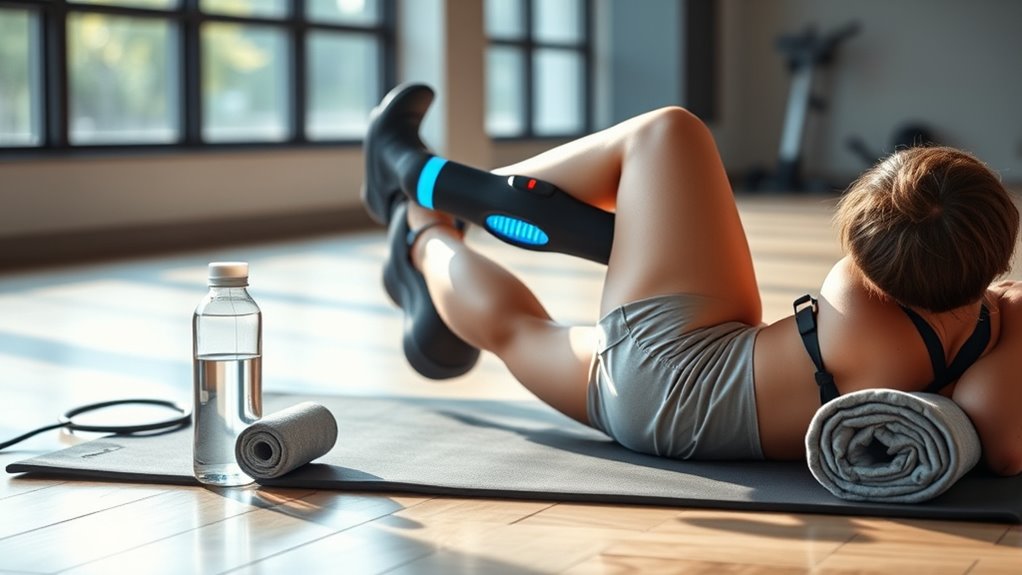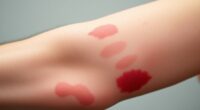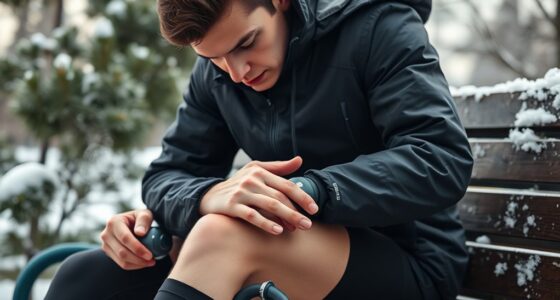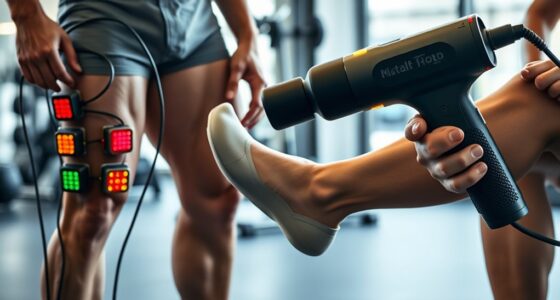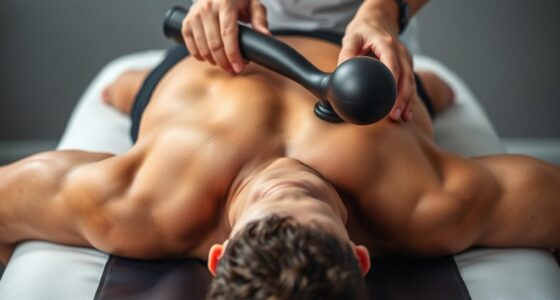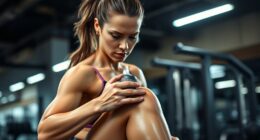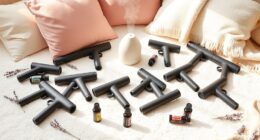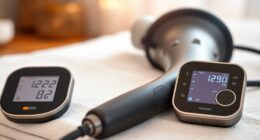To prevent DOMS, combine massage guns, stretching, and hydration into your routine. Use a massage gun after workouts to boost blood flow, loosen muscles, and reduce tension. Follow with effective stretching—foam rolling or PNF stretching— to enhance flexibility and break down adhesions. Staying well-hydrated replenishes electrolytes, flushes toxins, and supports muscle repair. Combining these strategies maximizes recovery and minimizes soreness, and if you keep exploring, you’ll discover even more ways to optimize your muscle health.
Key Takeaways
- Use massage guns during cool-down to boost circulation and reduce muscle tension, preventing DOMS onset.
- Incorporate effective stretching techniques, like foam rolling and PNF stretches, post-exercise to increase flexibility and reduce soreness.
- Maintain proper hydration before, during, and after workouts to support muscle recovery and flush out waste products.
- Combine massage therapy, stretching, and hydration regularly to enhance muscle elasticity and minimize tissue damage.
- Monitor soreness levels and adjust recovery routines accordingly to optimize prevention and ensure quicker muscle repair.
Understanding the Science Behind DOMS

Understanding the science behind Delayed Onset Muscle Soreness (DOMS) is essential to grasp why your muscles feel sore after unfamiliar or intense exercise. When you push your muscles beyond their usual limits, they undergo tiny tears, triggering muscle adaptation as your body repairs and strengthens the tissue. Neural fatigue also plays a role, as your nervous system becomes overstimulated from increased activity, leading to sensations of soreness and tiredness. This process isn’t just about muscle damage; it’s your body’s way of adapting to new demands. Recognizing that DOMS results from both muscle repair and neural fatigue helps you understand why recovery strategies are crucial. By easing these factors, you can reduce soreness and better prepare for future workouts. Incorporating various recovery methods can support your muscles and nervous system in healing more effectively.
How Massage Guns Accelerate Muscle Recovery
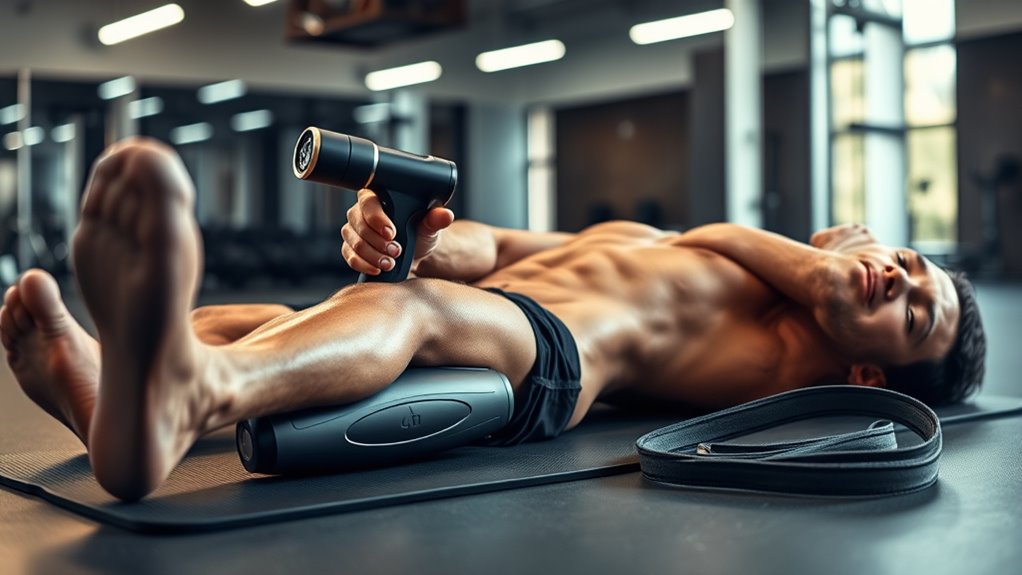
Massage guns boost your recovery by increasing blood flow to sore muscles, helping nutrients and oxygen reach the tissue faster. They also reduce muscle tension, easing tightness and discomfort. Together, these effects speed up healing and lessen the risk of delayed onset muscle soreness. Additionally, understanding AI safety measures can inform the development of smarter, safer recovery tools.
Increased Blood Flow
Using a massage gun increases blood flow to your muscles, which is essential for faster recovery. Enhanced circulation delivers oxygen and nutrients that support muscle repair and reduce soreness. This circulatory enhancement also improves muscle elasticity, making your muscles more flexible and less prone to injury. As blood flows more freely, waste products like lactic acid are removed more efficiently, decreasing discomfort and swelling. By stimulating the microcirculation within your muscles, a massage gun helps accelerate the healing process after intense workouts. This increased blood flow not only aids recovery but also prepares your muscles for future activity, promoting overall muscle health. Improved circulation enhances nutrient delivery and waste removal, further supporting effective recovery. Regular use ensures your muscles stay supple, resilient, and ready to perform at their best.
Reduced Muscle Tension
Increased blood flow helps remove waste products and delivers nutrients, but it also plays a direct role in easing muscle tension. When you use a massage gun, it stimulates your muscles, promoting better muscle elasticity and reducing stiffness. This process helps relax tight muscles, making movement smoother and more comfortable. As muscle tension decreases, your pain perception lessens, helping you feel less discomfort during recovery. Additionally, the muscle recovery benefits of massage guns are enhanced by their ability to target specific areas effectively. You’ll notice:
- Improved muscle elasticity, making muscles less prone to injury
- Reduced pain perception, easing soreness
- Faster recovery by loosening tight muscles
Using a massage gun regularly helps maintain relaxed muscles, preventing unnecessary tension buildup and supporting overall muscle health. This targeted approach accelerates recovery and keeps you ready for your next workout.
Effective Stretching Techniques to Reduce Soreness
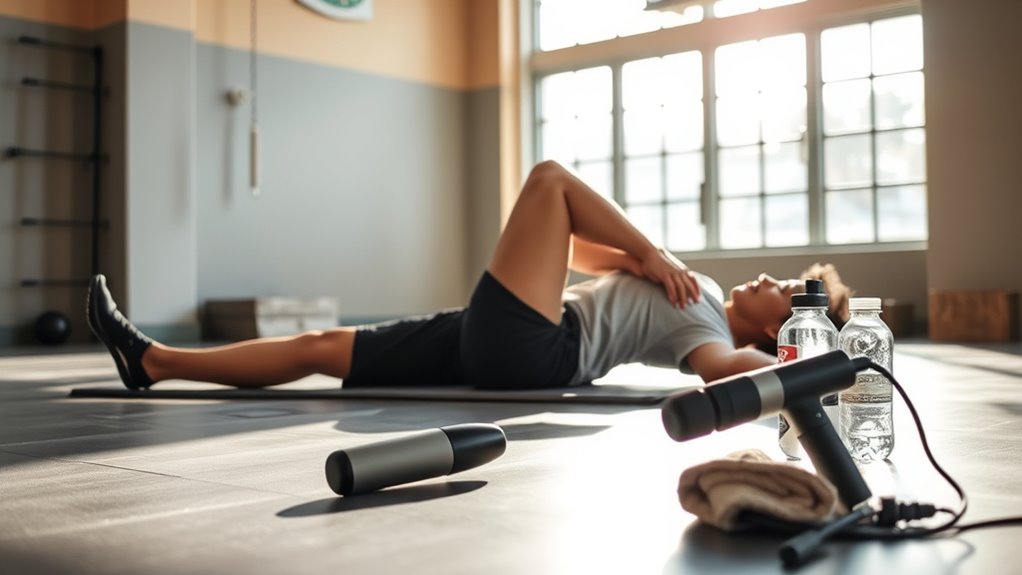
To effectively reduce muscle soreness after exercise, incorporating proper stretching techniques can be highly beneficial. Foam rolling is an effective method that helps release muscle tightness and improve blood flow, reducing soreness. Spend a few minutes rolling over key muscle groups, focusing on tender areas. PNF stretching, or proprioceptive neuromuscular facilitation, involves alternating stretches with gentle contractions, which can enhance flexibility and decrease post-exercise pain. Use this technique carefully, holding stretches for 10-30 seconds and gradually increasing intensity. Combining foam rolling with PNF stretching helps break down adhesions, relax muscles, and promote recovery. Additionally, understanding GMC tuning principles can assist in optimizing recovery strategies for performance enhancement. These techniques, when done consistently after workouts, can considerably reduce DOMS and improve your overall muscle resilience.
The Role of Hydration in Muscle Health and Recovery

Proper hydration is essential for maintaining muscle function and speeding up recovery after exercise. When you’re well-hydrated, your body maintains electrolyte balance, which helps prevent cramps and muscle fatigue. Drinking enough water also promotes mineral replenishment, ensuring your muscles have the nutrients they need to recover properly. To optimize hydration, consider these tips:
- Drink water consistently before, during, and after workouts
- Incorporate electrolyte-rich drinks to restore mineral levels
- Monitor your urine color to ensure proper hydration
- Incorporating hydration strategies can further enhance your recovery process.
Staying hydrated helps flush out toxins and reduces inflammation, making recovery smoother. It also supports muscle elasticity and reduces the risk of injury. Remember, hydration isn’t just about drinking water — it’s about maintaining a balance that keeps your muscles healthy and ready for your next workout.
Combining Strategies for Maximum Effectiveness
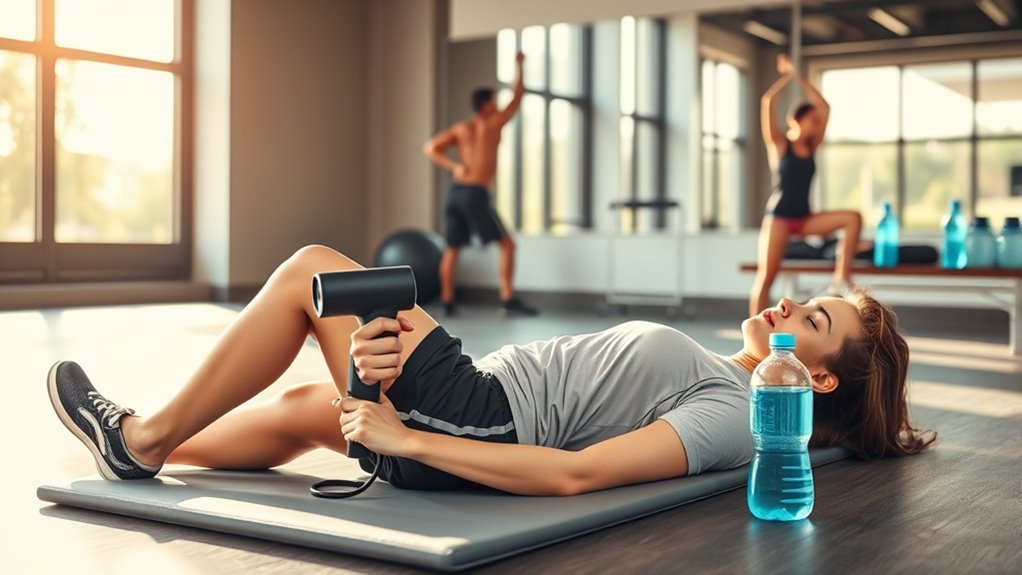
Combining different recovery strategies can substantially enhance your ability to prevent delayed onset muscle soreness (DOMS) and optimize overall muscle health. When you integrate massage guns, stretching, and proper hydration, you support muscle elasticity and reduce stiffness. Massage guns increase blood flow, helping to loosen tight muscles and prepare them for activity. Stretching maintains flexibility, which is vital for injury prevention and maintaining muscle elasticity. Hydration ensures your muscles stay supple and recover efficiently. Additionally, understanding the importance of indoor air quality can help create a healthier environment that supports overall physical well-being. By combining these methods, you create a holistic approach that addresses multiple factors contributing to DOMS. This synergy not only accelerates recovery but also strengthens muscles, reducing the risk of injury and improving overall performance. Implementing these strategies together maximizes their effectiveness for long-term muscle health.
Tips for Incorporating These Methods Into Your Routine

Incorporating these recovery methods into your routine requires intentional planning and consistency. To make them stick, schedule massage gun sessions, stretching, and hydration around your workouts. Prioritize post workout nutrition to replenish energy and support muscle repair, and aim for good sleep quality to enhance recovery. Be mindful of narcissistic traits in your interactions to maintain healthy boundaries and prevent manipulation. Here are some tips to help you integrate these methods seamlessly:
- Use a massage gun during cool-down to reduce muscle tension and improve circulation
- Incorporate stretching into your post-workout routine to increase flexibility
- Drink water regularly throughout the day to stay hydrated and optimize recovery
Monitoring Progress and Adjusting Your Approach

To prevent DOMS, you need to keep an eye on your recovery metrics, like soreness levels and performance. If you notice persistent discomfort or a dip in your progress, it’s time to adjust your training or recovery methods. Regularly monitoring helps you fine-tune your approach for better results and less soreness. Engaging with community tools or resources can also provide valuable feedback and support to optimize your recovery strategies.
Track Recovery Metrics
Tracking your recovery metrics is essential to understanding how your body responds to exercise and preventing delayed onset muscle soreness (DOMS). By monitoring key indicators, you can better gauge your recovery timeline and optimize your approach. Pay attention to:
- Changes in muscle elasticity, which reflect how flexible and resilient your muscles are becoming.
- Pain levels and soreness intensity to identify when muscles are fully recovered.
- Resting heart rate and fatigue levels, signaling your overall recovery status.
- Incorporating data-driven strategies can help you make informed adjustments to your recovery routine.
Keeping tabs on these metrics helps you adjust your stretching, hydration, and massage routines effectively. When you notice improvements in muscle elasticity and a decrease in soreness, you’re on the right track. Conversely, stagnation indicates it’s time to modify your recovery strategies.
Adjust Strategies Accordingly
Monitoring your progress allows you to identify whether your recovery strategies are effective or need adjustment. Pay attention to how your body responds, especially in terms of soreness and fatigue. If you notice persistent discomfort, evaluate your post workout nutrition—are you fueling properly with proteins and electrolytes? Also, assess your sleep quality, since restorative sleep is essential for muscle repair. If sleep is disrupted or insufficient, consider adjusting your bedtime routine or reducing screen time before bed. Tracking these factors helps you decide whether to intensify massage gun sessions, extend stretching, or tweak hydration habits. Regularly reviewing your recovery allows you to fine-tune your approach, ensuring you prevent DOMS more effectively and optimize your overall progress. Additionally, understanding resources and tools available can help you access expert guidance or support systems to enhance your recovery plan.
Frequently Asked Questions
Can Dietary Supplements Help Prevent DOMS Effectively?
Dietary supplements can support your efforts to prevent DOMS, especially when combined with proper nutritional timing. Supplements like branched-chain amino acids or omega-3s may reduce inflammation and muscle soreness. By timing your intake around workouts, you optimize recovery. While supplements aren’t a guaranteed fix, they can complement your hydration, stretching, and massage routines, helping you recover faster and minimize post-exercise soreness effectively.
How Does Temperature Therapy Compare to Massage Guns for Recovery?
You might find temperature therapy and massage guns both effective for recovery techniques. Temperature therapy, like hot or cold packs, promotes muscle relaxation and reduces inflammation, helping your muscles recover faster. Massage guns, on the other hand, increase blood flow and break up muscle tension through targeted vibrations. Both methods support recovery, but temperature therapy is better for soothing soreness, while massage guns offer more active muscle relaxation. Combining them could optimize your recovery process.
Are There Specific Workout Types That Cause More DOMS?
Certain workout types, especially those with high workout intensity or new movements, tend to cause more DOMS. When your muscles undergo unfamiliar stress, your body needs to adapt, leading to soreness. Exercises like heavy weightlifting or eccentric-focused workouts challenge muscle adaptation, increasing DOMS risk. To minimize this, gradually increase workout intensity and allow adequate recovery time, helping your muscles adapt more efficiently and reducing soreness afterward.
What Are Signs Indicating Over-Recovery or Injury Risks?
You should watch for signs like muscle stiffness that persists or worsens, and unusual pain that feels sharp or different from typical soreness. These symptoms can indicate over-recovery or injury risks. If you notice these, reduce activity, rest, and seek medical advice if needed. Ignoring such signs might lead to more serious damage, so listen to your body and avoid pushing through pain.
How Long Should Each Recovery Method Be Applied for Optimal Results?
For ideal timing, follow duration guidelines based on your recovery methods. Use a massage gun for about 1-2 minutes per muscle group, ensuring you don’t overdo it. Stretch each muscle for 15-30 seconds, focusing on areas that feel tight. Hydration should be maintained throughout the day, but drinking a glass of water within 30 minutes post-exercise helps maximize recovery. Adjust these durations based on how your body responds.
Conclusion
Think of your muscles like a garden—regular care keeps it thriving. After a tough workout, using a massage gun, stretching, and staying hydrated is like watering, fertilizing, and pruning. I once ignored these steps and felt stuck in a cycle of soreness. But when I combined them, recovery sped up, and I was back to my best faster. By blending these strategies, you’ll nurture your muscles back to health, ready for your next challenge.
